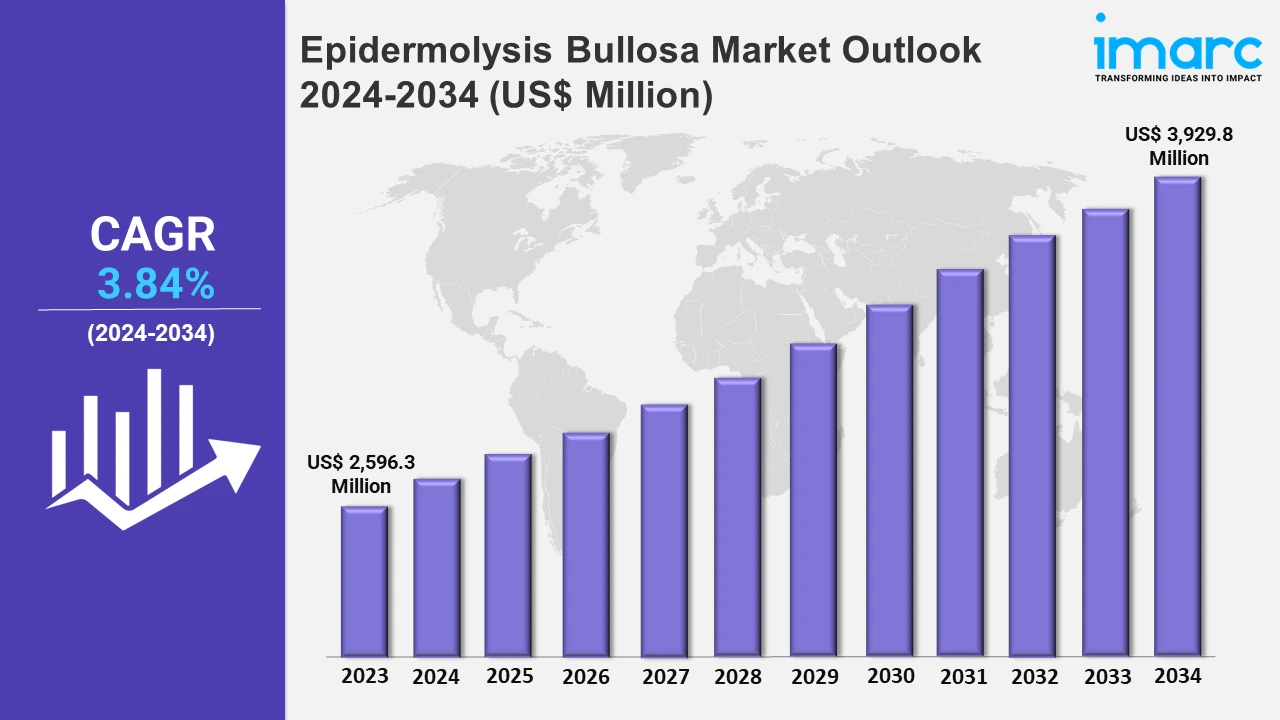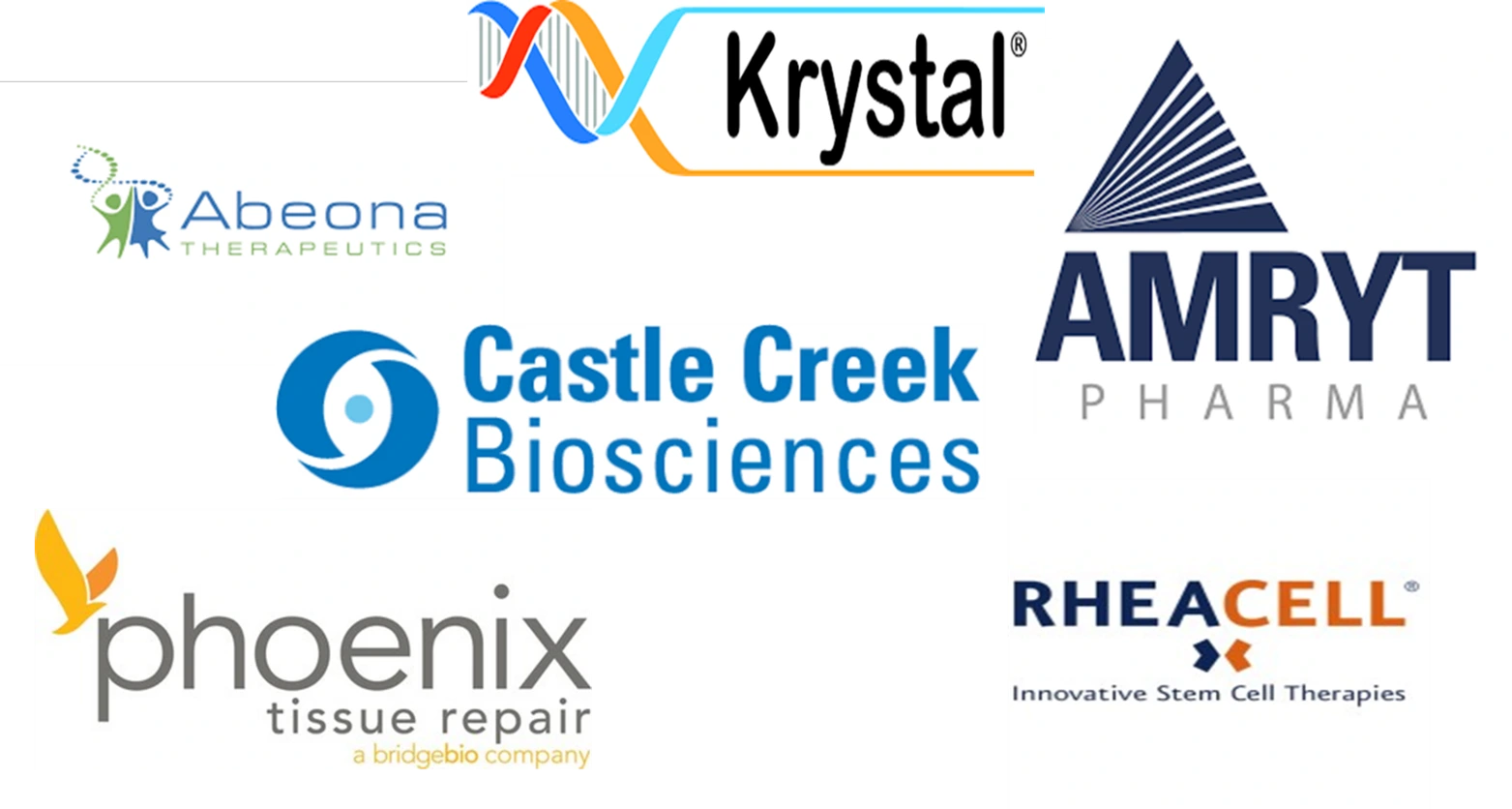Epidermolysis Bullosa Market Size to Reach US$ 3,929.8 Million by 2034, Impelled by Advancements in Early Detection
Epidermolysis Bullosa Market Outlook 2024-2034:
The epidermolysis bullosa market size reached a value of US$ 2,596.3 Million in 2023. Looking forward, the market is expected to reach US$ 3,929.8 Million by 2034, exhibiting a growth rate (CAGR) of 3.84% during 2024-2034. The market is driven by the emerging popularity of protein replacement therapies, which can replace the missing or defective protein to potentially reverse the structural and molecular defects in the skin. Additionally, the development of targeted therapies and innovative treatments is further propelling the market growth.

To get more information on this market, Request Sample
Advances in Early Detection and Diagnostic Technologies: Driving the Epidermolysis Bullosa Market
Advances in early detection and diagnostic technologies are significantly driving growth in the epidermolysis bullosa (EB) market by enhancing disease identification, classification, and management. Genetic testing, particularly next-generation sequencing (NGS), has become a cornerstone for diagnosing EB. NGS enables precise identification of mutations in genes such as COL7A1, KRT5, and others associated with various EB subtypes. This facilitates not only early diagnosis but also subtype-specific treatment planning and prognosis assessment. Additionally, advancements in non-invasive prenatal testing (NIPT) allow for early detection of high-risk pregnancies, offering families critical decision-making opportunities. Furthermore, imaging technologies, including confocal microscopy and optical coherence tomography, are providing dermatologists with detailed insights into skin structures and lesion depth without the need for invasive procedures. Combined with biomarker research, these tools enhance diagnostic accuracy and help monitor disease progression in real-time. Besides this, the integration of artificial intelligence (AI) and machine learning into diagnostic workflows is another transformative trend. AI algorithms analyze clinical images and genetic data, expediting diagnosis and enabling personalized treatment strategies. Furthermore, the development of comprehensive EB registries and databases supports epidemiological studies and paves the way for targeted therapies. Early detection and precise diagnostics not only improve patient outcomes by enabling timely interventions but also fuel pharmaceutical innovation. By identifying patient populations more effectively, these technologies drive clinical trial efficiency and support regulatory approvals for novel therapies.
Development of Novel Therapies and Pharmacological Treatments: Contributing to Market Expansion
The development of novel therapies and pharmacological treatments is playing a pivotal role in the expansion of the epidermolysis bullosa market, addressing unmet needs for this debilitating and rare genetic disorder. Moreover, recent advancements in biotechnology and pharmacology are transforming the therapeutic landscape with innovative solutions aimed at disease modification and enhanced quality of life. Gene therapies have emerged as a groundbreaking area, offering the potential to address the root cause of EB by correcting defective genes responsible for the disorder. Technologies like CRISPR-Cas9 and viral vector-based gene delivery systems are at the forefront, enabling targeted genetic corrections in specific EB subtypes, such as recessive dystrophic epidermolysis bullosa (RDEB). Clinical trials have shown promising results, bolstering investor confidence and encouraging further innovation. Pharmacological advancements, including protein replacement therapies and anti-inflammatory agents, are expanding treatment options. For instance, recombinant collagen VII therapies are addressing structural deficiencies in the skin, significantly improving wound healing and reducing disease complications. Biologic therapies targeting inflammatory pathways are also gaining traction, mitigating chronic inflammation and promoting skin integrity. Topical treatments, such as growth factor-enriched dressings and cell-based therapies, are enhancing wound management strategies. Additionally, advancements in cell and tissue engineering, including stem cell therapies and bioengineered skin grafts, are offering regenerative solutions for severe cases.
Marketed Therapies in Epidermolysis Bullosa Market
Filsuvez (Birch triterpenes): Amryt Pharma
Filsuvez is a topical gel that promotes wound healing in persons with dystrophic epidermolysis bullosa or junctional epidermolysis bullosa in adult and pediatric patients 6 months of age and older. It is specifically designed for the treatment of partial-thickness wounds, which do not extend beyond the skin's dermis layer. The drug modulates inflammatory mediators and stimulates keratinocyte differentiation and migration, enabling wound healing and closure.
Emerging Therapies in Epidermolysis Bullosa Market
Allo-APZ2-EB: Rheacell
Allo-APZ2-EB is a treatment for epidermolysis bullosa that uses allogeneic skin-derived ABCB5-positive mesenchymal stem cells (MSCs). MSCs are extracted from human skin and can be divided into many lineages. These MSCs have anti-inflammatory capabilities and can interact with immune cells to reprogram them and create collagen VII, laminin, and keratin 14. Allo-APZ2-EB may help control inflammation and tissue repair. This therapeutic drug is delivered by infusion.
Beremagene Geperpavec: Krystal Biotech
Beremagene Geperpavec is a topical gene therapy developed by Krystal Biotech to treat dystrophic epidermolysis bullosa. Beremagene geperpavec is a live, replication-defective herpes simplex virus type 1 (HSV-1)-based vector therapy. This drug is indicated to eradicate dystrophic epidermolysis bullosa at the molecular level by giving the patient's skin cells the template to produce normal COL7 protein, hence treating the disease's underlying mechanism.
FCX-007: Castle Creek Pharmaceuticals
FCX-007, commonly referred to as D-Fi, is a gene therapy treatment for dystrophic epidermolysis bullosa and recessive epidermolysis bullosa. FCX-007 is a genetically modified (altered) version of an individual's cells. The drug is intended to introduce a functional version of the collagen VII protein that is absent in recessive epidermolysis bullosa patients into the skin.
EB-101: Abeona Therapeutics
EB-101 is an autologous, engineered cell therapy currently in development for the treatment of recessive dystrophic epidermolysis bullosa. EB-101 gene therapy consists of a correct copy of the COL7A1 gene packaged into a virus known as a retrovirus, which is then transferred into a patient's skin cells (keratinocytes) that were initially cultivated in a laboratory outside the patient's body (ex-vivo). Following gene transfer, skin cells are allowed to proliferate and form sheets that act as skin grafts by expressing functional type VII collagen protein. These genetically altered skin grafts are subsequently placed into the patient to cure wounds and blisters while also restoring normal type VII collagen expression in the skin.
PTR 01: Phoenix Tissue Repair Inc
PTR-01 is an experimental protein replacement medication that treats recessive dystrophic epidermolysis bullosa with recombinant collagen type VII (rC7). PTR-01 is intended to be systemically available via intravenous injection. PTR-01 is designed to replace the faulty collagen VII protein in recessive dystrophic epidermolysis bullosa, which can help heal the chronic wounds associated with the condition.
| Drug Name | Company Name | MOA | ROA |
|---|---|---|---|
| Allo-APZ2-EB | Rheacell | Cell replacements | Intravenous |
| Beremagene Geperpavec | Krystal Biotech | COL7A1 protein replacements; Gene transference | Topical |
| FCX-007 | Castle Creek Pharmaceuticals | Cell replacements; Collagen type VII replacements; Gene transference | Intradermal |
| EB-101 | Abeona Therapeutics | COL7A1 protein replacements; Gene transference | Intravenous |
| PTR-01 | Phoenix Tissue Repair Inc | Collagen type VII replacements | Intravenous |
Detailed list of emerging therapies in Epidermolysis Bullosa is provided in the final report.
Leading Companies in the Epidermolysis Bullosa Market:
The market research report by IMARC encompasses a comprehensive analysis of the competitive landscape in the market. Across the global epidermolysis bullosa market, several leading companies are at the forefront of developing integrated platforms to enhance the management of epidermolysis bullosa. Some of the major players include Amryt Pharma. This company is driving innovation in the epidermolysis bullosa market through continuous research, diagnostic tools, and expanding its product offerings to meet the growing demand for the illness.
In December 2023, Chiesi Global Rare Diseases reported that the United States FDA had approved FILSUVEZ (birch triterpenes) topical gel for the treatment of partial thickness wounds in patients 6 months and older with junctional epidermolysis bullosa and dystrophic epidermolysis bullosa.
Key Players in Epidermolysis Bullosa Market:
The key players in the Epidermolysis Bullosa market who are in different phases of developing different therapies are Amryt Pharma, Rheacell, Krystal Biotech, Castle Creek Pharmaceuticals, Abeona Therapeutics, Phoenix Tissue Repair Inc., and Others.

Regional Analysis:
The major markets for epidermolysis bullosa include the United States, Germany, France, the United Kingdom, Italy, Spain, and Japan. According to projections by IMARC, the United States has the largest patient pool for epidermolysis bullosa while also representing the biggest market for its treatment. This can be attributed to government support through funding initiatives and partnerships with academic institutions that enhance clinical trials and therapeutic pipeline development.
Moreover, one of the primary drivers is the advancement in gene and cell-based therapies, exemplified by treatments like EB-101, which offer disease-modifying potential. These cutting-edge approaches are transforming the treatment landscape by addressing the root causes of EB rather than merely managing symptoms.
Besides this, various regulatory incentives, such as orphan drug designations and fast-track approvals provided by the U.S. Food and Drug Administration (FDA), further accelerate the development and commercialization of novel therapies.
Recent Developments in Epidermolysis Bullosa Market:
- In November 2024, Abeona Therapeutics Inc. announced that the FDA had accepted for review Abeona's resubmission of its Biologics License Application (BLA) for prademagene zamikeracel (pz-cel), an investigational autologous cell-based gene therapy, as a potential new treatment for recessive dystrophic epidermolysis bullosa. The FDA had designated April 29, 2025, as the target date for acting under the Prescription Drug User Fee Act (PDUFA).
- In May 2023, Krystal Biotech, Inc. stated that the U.S. FDA had approved VYJUVEK (beremagene geperpavec-svdt) for the treatment of dystrophic epidermolysis bullosa in individuals six months of age and older. VYJUVEK is intended to address the genetic etiology of dystrophic epidermolysis bullosa by delivering functional copies of the human COL7A1 gene, which promotes wound healing and long-term functional COL7 protein expression with redosing.
Key information covered in the report.
- Base Year: 2023
- Historical Period: 2018-2023
- Market Forecast: 2024-2034
Countries Covered
- United States
- Germany
- France
- United Kingdom
- Italy
- Spain
- Japan
Analysis Covered Across Each Country
- Historical, current, and future epidemiology scenario
- Historical, current, and future performance of the epidermolysis bullosa market
- Historical, current, and future performance of various therapeutic categories in the market
- Sales of various drugs across the epidermolysis bullosa market
- Reimbursement scenario in the market
- In-market and pipeline drugs
Competitive Landscape:
This report offers a comprehensive analysis of current epidermolysis bullosa marketed drugs and late-stage pipeline drugs.
In-Market Drugs
- Drug Overview
- Mechanism of Action
- Regulatory Status
- Clinical Trial Results
- Drug Uptake and Market Performance
Late-Stage Pipeline Drugs
- Drug Overview
- Mechanism of Action
- Regulatory Status
- Clinical Trial Results
- Drug Uptake and Market Performance
About Us:
IMARC Group is a global management consulting firm that helps the world’s most ambitious changemakers to create a lasting impact. Across the six major continents and 100+ countries, we work alongside our business partners as one team with a common ambition to achieve unparallelled results, gain a competitive edge, and transform industries. IMARC Group excels in understanding its clients’ business priorities and delivering tailored solutions that drive meaningful outcomes. Our client base spans over 3,000 organizations in the private, public, and social sectors, ranging from high-growth startups to Fortune 500 companies.
Contact US
IMARC Group
134 N 4th St. Brooklyn, NY 11249, USA
Email: Sales@imarcgroup.com
Tel No:(D) +91 120 433 0800
Phone Number: - +1 631 791 1145, +91-120-433-0800
Need more help?
- Speak to our experienced analysts for insights on the current market scenarios.
- Include additional segments and countries to customize the report as per your requirement.
- Gain an unparalleled competitive advantage in your domain by understanding how to utilize the report and positively impacting your operations and revenue.
- For further assistance, please connect with our analysts.

 Inquire Before Buying
Inquire Before Buying
 Speak to an Analyst
Speak to an Analyst
 Request Brochure
Request Brochure




.webp)




.webp)












